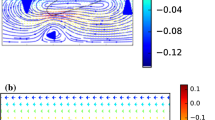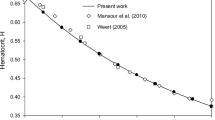Abstract
The transmitted light strength (TS) through a thin blood layer changes with variation in blood flow, such as positive streaming transparency for low hematocrits and negative streaming transparency for high hematocrits. These phenomena are examined theoretically and experimentally. Maxwell’s equations are solved assuming that erythrocytes are oblate spheroids to investigate these phenomena due to flowing blood. The theoretical results reveal that the scattering and absorption cross sections for flowing blood are larger than those for stagnant blood. Experimental results indicate that the TS for both oxygenated and deoxygenated flowing blood, with a hematocrit of up to approximately 20%, was stronger than that for stagnant blood. The TS decreased for flowing blood with a hematocrit of approximately 20% or greater. Applying the theoretical scattering and absorption cross sections to the absorption and multiple scattering theory of Victor Twersky, the changes in the TS due to flowing blood are obtained theoretically. From the theoretical and experimental results, the positive streaming transparency phenomenon of flowing blood with a low hematocrit and the negative streaming transparency phenomenon with a high hematocrit are found to result from increased scattering and absorption cross sections because of the orientation of flowing erythrocytes.









Similar content being viewed by others
References
Kuroda K, Fujino M. On the cause of the increase in light transparency of erythrocyte suspension in flow. Biorheology. 1963;1:167–82.
Kuroda K, Fujino M. Streaming transparency of erythrocyte suspension. Biorheology. 1964;2:97.
Yanami Y, Intaglieta M, Frasher WG, Wayland H. Photometric study of erythrocytes in shear flow. Biorheology. 1964;2:165–8.
Niwa M, Sakamoto K, Kanai H. Optical reflection by whole blood—the effects of erythrocytes orientation. In: Digest of the 11th ICMBE in Ottawa, Canada. 1976;074.
Asano S, Yamamoto G. Light scattering by a spheroidal particle. Appl Opt. 1975;14(1):29–49.
Tsinopoulos SV, Polyzos D. Scattering of He–Ne laser light by an average-sized red blood cell. Appl Opt. 1999;38(25):5499–510.
Twersky V. Absorption and multiple scattering by biological suspensions. J Opt Soc Am. 1970;60(8):1084–93.
Tsinopoulos SV, Sellountos EJ, Polyzos D. Light scattering by aggregated red blood cells. Appl Opt. 2002;41(7):1408–17.
Flammer C. Spheroidal wave functions. Stanford U. P.: Stanford: Calif. 1957.
Constantinides GN, Gintides D, Kattis SE, Kiriaki K, Paraskeva CA, Payatakes AC, PoIyzos D, TsinopouIos SV, Yannopou1os SN. Computation of light scattering by axisymmetric nonspherical particles and comparison with experimental results. Appl Opt. 1998;37(31):7310–9.
Bohren CF, Huffman DR. Absorption and scattering of light by small particles. New York: Wiley; 1998.
Asano S. Light scattering properties of spheroidal particles. Appl Opt. 1979;18(5):1712–23.
Weil H, Chu C-M. Scattering and absorption of electromagnetic radiation by thin dielectric disks. Appl Opt. 1976;15(7):1832–6.
Stratton JA. Electromagnetic theory. New York: McGraw-Hill; 1947.
Smythe WR. Static and dynamic electricity. New York: Mcgraw-hill book company; 1968.
CHU LJ, Straton JA. Forced Oscillation of a prolate spheroid. J Appl Phys. 1941;12:241–8.
Chu LJ, Straton A. Elliptic and spheroidal wave functions. J Math Phys 1941;20(3):259–309.
Hulst HC. Light scattering by small particles. New York: Wiley; 1957.
Hans AE, Stamnes JJ, Stamnes K, Schulz FM. New method for computing expansion coefficients for spheroidal functions. J Quant Spectrosc Radiat Transf. 1999;63:191–203.
Hodge DB. Eigenvalues and Eigenfunctions of the spheroidal wave equation. J Math Phys. 1970;11(8):2308.
Sinha BP, Macphie RH, Prasad T. Accurate computation of eigenvalues for prolate spheroidal wave functions. IEEE Trans Antennas Propagat (CPD). 1973;AP-21:406–7.
Sinha BP, Macphie RH. Electromagnetic from prolate spheroids for axial incidence. IEEE Trans Antennas Propagat. 1975;AP-23:676–9.
Sakamoto K, Kanai H. Electrical characteristics of blood. IEEE Trans BME. 1979;BME-26(12):686–95.
Sakamoto K, Fujii M, Kanai H. Optical properties of steadily and sinusoidally flowing blood. MBEC. 1996;supplement 1(34):167–8.
Sakamoto K, Fujii M, Kanai H. Physical properties of human blood at low shear rate. Med Biol Eng Comput. 1996;34:169–70.
Sakamoto K, Fujii M, Kanai H. Orientation and deformation of erythrocytes in flowing blood. N Y Acad Sci. 1999;873:245–62.
Fujii M, Sakamoto K, Nakajima K, Kanai H. Physical properties of the flowing blood—orientation and deformation of erythrocytes. Med Biol Eng Comput. 1999;37:104–5.
Twersky V. Interface effects in multiple scattering by large, low-refracting, absorbing particles. J Opt Soc Am. 1970;60(7):908–14.
Lee VS, Tarassenko L. Absorption and multiple scattering by suspensions of aligned red blood cells. J Opt Soc Am. 1991;8(7):1135–41.
Schmitt JM, Meincl JD, Mihm FG. An integrated circuit-based optical sensor for in vivo measurement of blood oxygenation. IEEE Trans BME. 1986;BME-33(2):98–107.
Roggan A, Friebel M, Dorschel K, Hahn A, Muller G. Optical properties of circulating human blood in the wavelength range 400–2500 nm. J Biomed Opt. 1999;4(1):36–46.
Zdrojkowski RJ, Pisharoty NR. Optical transmission and reflection by blood. IEEE Trans Bio-Med Eng. 1970;BME-17(2):122–7.
Grody E, Drabkin DL. Determination of the oxygen saturation of blood by a simplified technique applicable to standard equipment. J Biol Chem. 1957;227:285.
Ganong WF. Review of medical physiology. 21st ed. New York: McGraw-Hill Companies In. Co.
Guyton C, Hall JE. Text book of medical physiology. 9th ed. Philadelphia: W.B. Saunders Company.
Mullaney PF, Dean PN. The small angle light scattering of biological cells. Biophys J. 1970;10:764–72.
Acknowledgments
We wonder if these phenomena discussed above cause the measurement errors in various optical inspection machines. We hope the theoretical and experimental results will be of help to elucidate the measurement errors in various optical inspection machines. The authors wish to thank Prof. S. Asano, Tohoku University, for his kind advice in numerical computation. We also appreciate the students of Kitasato University and Chiba Institute of Science for their assistances in the experiments.
Author information
Authors and Affiliations
Corresponding author
About this article
Cite this article
Sakamoto, K., Furuya, N., Kanai, H. et al. Optical characteristics of flowing blood. J Biorheol 25, 52–63 (2011). https://doi.org/10.1007/s12573-011-0038-z
Received:
Accepted:
Published:
Issue Date:
DOI: https://doi.org/10.1007/s12573-011-0038-z




